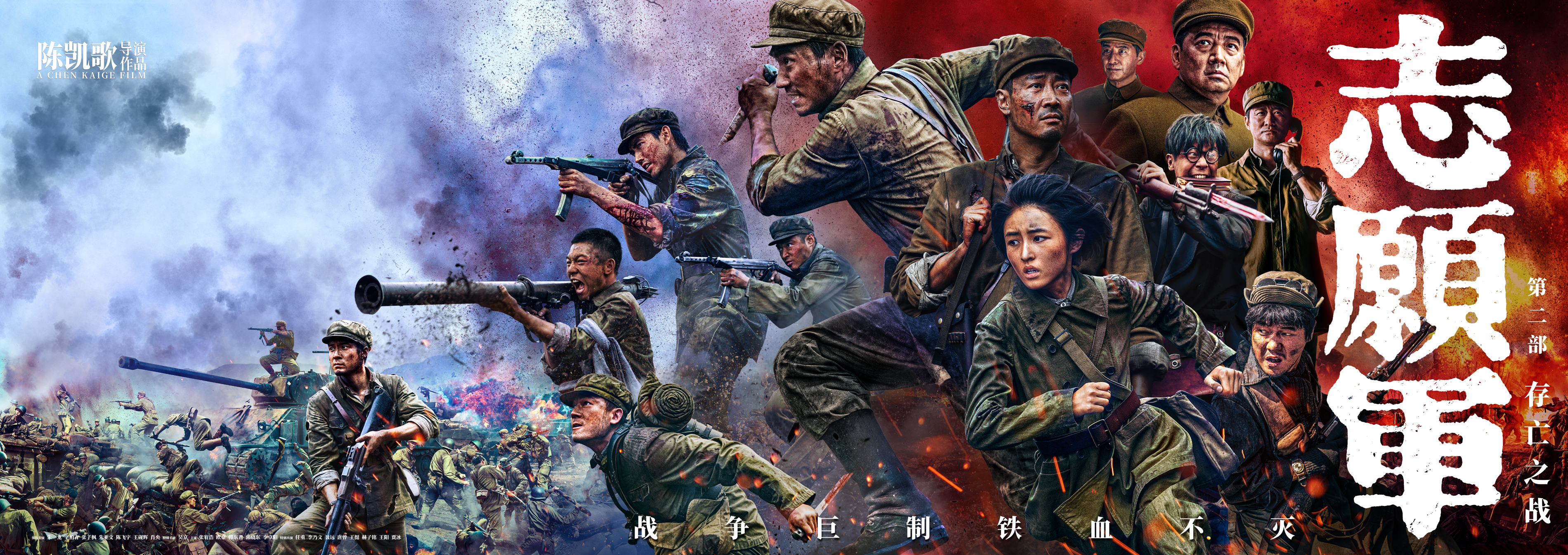
In 2023, to commemorate the 70th anniversary of the victory in the Korean War, the "Volunteers" trilogy directed by Chen Kaige premiered. The first installment, "Volunteers: Heroes Strike," which focuses on the decision to deploy troops and the initial battles fought by the Chinese People's Volunteer Army in Korea, was released and became the box office champion for its time slot. A year later, coinciding with National Day, the second part, "Volunteers: Battle of Survival," was released once again.

Poster
The story of "Volunteers: Battle of Survival" revolves around the battle at Tieyuan during the fifth conflict of the Korean War.
In May 1951, the Chinese People's Volunteer Army and the People's Army fought continuously for a month under dire conditions of fatigue and shortages of food and ammunition. Under orders from the Sino-Korean Joint Command, the main forces of various corps began to relocate northward to recuperate. However, in the early stages of the withdrawal, the "United Nations forces" launched a large-scale counterattack. The 63rd Army was urgently tasked with a mission, and 25,000 troops engaged nearly 50,000 "United Nations forces" in intense combat at Tieyuan, enduring 12 days and nights to withstand multiple charges coordinated by enemy infantry, armor, and artillery. This battle completely shattered the enemy's scheme to destroy the Volunteer Army's rear bases and eliminate its main forces, playing a vital role in stabilizing the situation on the Korean battlefield.
At the premiere of "Volunteers: Battle of Survival," Fu Liang, a classmate of director Chen Kaige from Beijing's Fourth Secondary School, spoke up: "We were both born in 1952. When we were born, this war was still ongoing. As we grew a little older, many adults around us had just returned from the battlefield of the Korean War. I can say that from childhood, I had met real Volunteer Army soldiers and interacted with these heroes. I never expected that, after six decades, I would see so many young actors vividly reenacting the story of the Korean War under the direction of Kaige. Over the years, we've experienced a lot of joys and sorrows, and I thought I had become quite hardened, but I indeed shed tears while watching this film."

Chen Kaige
Fu Liang's remarks deeply moved Chen Kaige as well. "When we were in school together at the Fourth Secondary School, I never imagined that years later, you would be sitting here watching a film made by me." This nostalgic exchange between old classmates served as a reminder that although the war has been washed away by time, it should not be forgotten by the Chinese people.
"What I fear most is that these people will be forgotten. This is the greatest motivation for me to make the 'Volunteers' trilogy. In a nutshell, all honors belong to the Chinese People's Volunteer Army." In an interview with The Paper, Chen Kaige stated, "I calculated that the total number of shots in the trilogy is over 12,000—typically, an action film has at most 2,000 shots. What does it mean to grind? It means grinding with time, grinding with our patience, and grinding with our desire to make a good movie. In the end, we shortened the time and finished the film."

Onset photo featuring actors
How do you recreate a war that occurred 70 years ago? In "Volunteers: Battle of Survival," soldier Li Xiang receives his order to return to the front lines in Korea shortly after returning to Beijing. He skillfully ties up his leg wraps and packs his backpack, with sunlight streaming through the window evenly covering him, as his deft movements stir up the dust around him. That “spirit of heroism,” captured in an instant on the big screen, comes to life.
This scene may evoke memories of Chen Kaige's own experiences at the age of 19. That year, young Kaige enlisted in the army in Yunnan, and when he heard the urgent assembly call, he too would have prepared himself in a similar manner.
【Dialogue】
It’s time for war films to upgrade and evolve.
The Paper: Over the years, I have been closely following your films. Particularly in 2019, during the preparation for "My People, My Country," you proposed "historical moments, collective memory, and collision," which succinctly opened up a new path for the production of commercial films with a main theme in the new era, raising the level of understanding. Directing the "Volunteers" trilogy, which is the first panoramic depiction of the great journey of the Korean War on the big screen, I would like to hear your overall thoughts and the creative genesis behind it.
Chen Kaige: I gave careful consideration to taking on the director's role for the "Volunteers" trilogy. I felt a strong creative ambition to make a trilogy about the Korean War, especially as there have been several films made over the decades, and I believe we could do it even better. War films are at a point where they need to upgrade and evolve.
I first thought, can battles be depicted genuinely? War scenes can easily come across as artificial, and if there are no demands, they will likely appear so. The second concern is whether humans and war can be intertwined in the narrative—what is a war without people? Without the specific expressions of human emotions and relationships, how can the audience connect with the film? This was how I planned it out.

Poster
The Paper: At the premiere of "Volunteers: Battle of Survival" (hereafter referred to as "Battle of Survival"), you proposed the eight-character motto "drama portrayed through action, action filmed with intensity." Does this encapsulate the gist of each part of the trilogy?
Chen Kaige: That's how we structured it. The first part, "Volunteers: Heroes Strike," serves as the origin story—how the battle started, what led to the decision, and what circumstances New China was in at that time. Clearly outlining these details is very important. The second part, "Battle of Survival," allows for more focus on people during the war, specifically ordinary individuals. In this installment, the frequency of high-ranking officials appearing is lower. Whether it's in the Korean War or even the War of Resistance against Japan, it's the farmers of China who picked up arms to protect their home and country; they are the main subjects, and this historic truth must be restored in our film.
To be frank, I felt quite saddened while filming. The Tieyuan defensive battle featured in "Battle of Survival" was a fight between 25,000 volunteers and 50,000 "United Nations forces," lasting for 12 long days and nights. The actual situation was undoubtedly more brutal than what is depicted in the film. In one scene, amidst heavy rain, the soldiers in the trenches reflect on their hometown—why do Chinese people speak of home and country? These two words are closely tied to our entire historical and cultural context; the Chinese have their clans and families, on top of which lies our nation. This interconnected relationship is particularly significant for the film.
The third part is about preparing for peace, yet during this process, many conflicts and bloodshed continue to arise. Some may question whether it's worth spending four years to complete the "Volunteers" trilogy, considering that the third part might be released in the fifth year. I believe that because I have a strong commitment to authenticity in my creations, I deem this endeavor worthwhile. If it were merely about completing a task and not caring about the outcome, then that would indeed be unworthy.

Still from the film, Zhu Yilong (left) as Li Xiang, Zhang Zifeng (right) as Li Xiao
The Paper: Throughout the Korean War, numerous battles took place. Why did "Battle of Survival" emphasize the Tieyuan defensive battle? In my viewing experience, I noticed the Volunteer soldiers creatively employing tactics like guerrilla oil attacks and flood-based assaults due to their harsh conditions, which reminded me of references in "Romance of the Three Kingdoms."
Chen Kaige: I can't claim to be a military expert. However, it's clear from studying any side's military records that the Tieyuan defensive battle was difficult, particularly because the enemy had coordinated infantry and 300 tank units against our lightly armed infantry. Our supply lines were restricted by the enemy air force, preventing artillery ammunition from reaching the front lines, and we had no tanks to counter them. In this scenario, we could not afford to lose Tieyuan. The soldiers of the 63rd Army’s 188th Division could only dig trenches, relying on rifles, and the occasional Soviet-made PPSh-41 submachine guns, along with anti-tank grenades and captured or improvised bazookas to oppose the enemy. How do you win this battle? This sentiment echoes sentiments expressed by soldiers in the film: the enemy has strong firepower but lacks morale; we may have less firepower, but we have spirit! This phrase is derived from Chairman Mao’s remarks during the Korean War.
Thus, what I placed the utmost emphasis on during the depiction of the Tieyuan defensive battle was the close-combat scenes. We also increased the use of cold weapons in some ambush sequences. In close-quarter combat, it's life or death—picking up anything available to eliminate the enemy because it's a brutal battlefield; if I don't kill you, you'll kill me. Of course, as you mentioned with your historical analogy, this can also be derived from ancient combat methods. Combat is not just about bravery and spirit; it also requires precise, effective, and flexible tactics—especially when our firepower and troop numbers are inferior to the enemy's. Our forces employed clever strategies to achieve victory, such as setting up “gasoline arrays” in positions and filling bomb craters with water to obstruct the enemy tanks, which is one of the reasons we were so interested in the Tieyuan battlefield.
The Paper: In recent years, with the release of a number of domestic war films, our portrayal of combat has gradually aligned more with international standards. What did you find to be the most challenging war scene to shoot in "Battle of Survival"?
Chen Kaige: I could share countless statistics on this subject—there are approximately 25,000 pieces of clothing included in the film's wardrobe, and the uniforms alone weigh around 25,000 kg. The Tieyuan defensive battle, being the largest filming location in the "Volunteers" trilogy, required us to recreate a battlefield covering 200,000 square meters in Tianmo, Hebei, and the filming lasted up to three months, which was quite a “hard battle” in itself. This demanded immense patience from the entire crew; it's akin to sewing a garment, every stitch matters. If the lead actors perform well, but the extras in the background have inadequate expressions, we would need to reshoot. For example, the hand-to-hand combat scenes involved precise choreography where every move had to be meticulously planned; how soldiers were to break free after being taken down had to be carefully orchestrated, without any randomness.
"The flag is like the person, the person is like the flag."
The Paper: As a series of films offering a panoramic presentation of the Korean War, the "Volunteers" trilogy will undoubtedly emphasize both the "realities of command" and "realities in the trenches." Building on the foundation laid in the first installment, I personally feel that the second part places more focus on "trenches reality," showcasing the spiritual world and relationships of the characters. Using Li Muyin (played by Xin Baiqing) and his two children, Li Xiang (played by Zhu Yilong) and Li Xiao (played by Zhang Zifeng), as an example, can you share your thoughts on this dynamic?

Xin Baiqing (left) as Li Muyin, Zhu Yilong (right) as Li Xiang
Chen Kaige:


